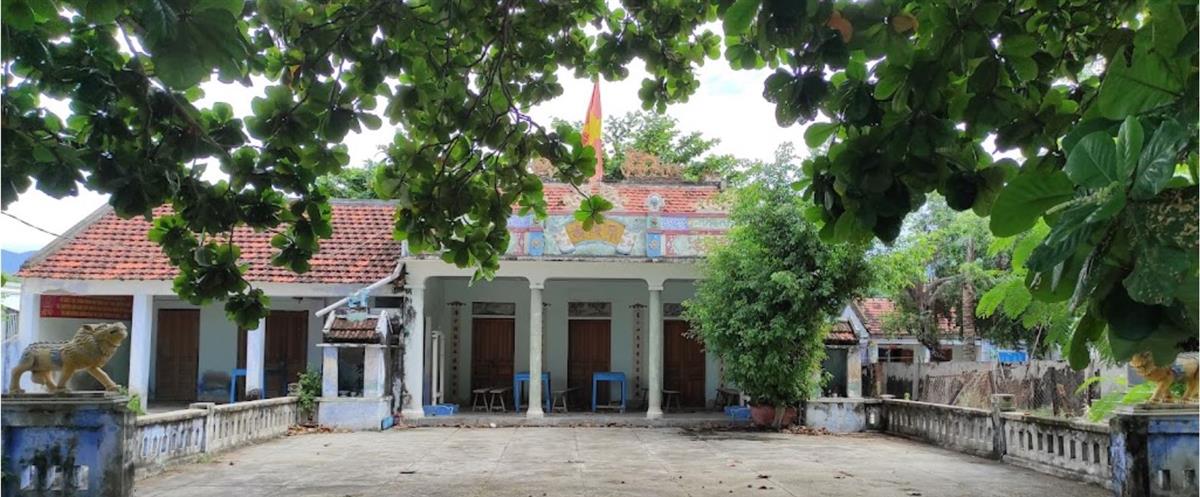Description
The relic is located in Phu Hoi village, Van Thang commune, Van Ninh district (formerly Phu Hoi Tay village, belonging to Ha canton, Quang Phuoc district, Binh Hoa province).
During the reign of King Minh Menh in the 3rd year (1823), some fishermen in Song Cau (Phu Yen) in turn came to the waters of Phu Hoi West village to settle down and settle down. Among those residents was Mr. Nguyen Hau, who brought his whole family into residence. In the 6th year of Tu Duc (1853), Nguyen Hau's eldest son, Nguyen Tac, discovered a Ca Co (female whale) "logged" on the beach near his house. Mr. Nguyen Tac and a fisherman in Phu Hoi Tay village carried out a Whale procession to bring back to be buried in the cemetery grounds in the current Phu Hoi mausoleum. Since the day Ca Co was buried, Mr. Nguyen Tac's family in particular and the fishing community in Phu Hoi Tay village in general went out to sea to catch more and more abundant seafood. After two years of mourning, in 1855 (8th Tu Duc date), in order to have a dignified place of worship, fishermen in the village built a small mausoleum (at the current mausoleum location) in the form of Thu Ky (with 4 pillars, roofs covered with coconut leaves, plastered around the earth); After that, thousands of creeks held a ceremony to open Co's bones and then a ceremony to "enter electricity". Phu Hoi mausoleum now worships the gods Nam Hai, Tho Cong, Tien sage (Mr. Nguyen Tac), Hau sien (Mr. Tran Huu Du), Ha Ba, and Son Lam.
Since its construction until now, there have been 10 times that Mr. and Ms. Nam Hai have "logged down" and Phu Hoi Mausoleum is worshiping 9 sarcophagi containing "jewel bones" (including 2 sets of Ong bones and 7 sets of Co bones). The most recent time was on November 4, 2012, there was another Co "luy" on the beach near the Mausoleum and is being buried at the cemetery land cPhu Hoi Mausoleum is located on a coastal sandy beach, with an area of 1,120 m2. From the outside to the inside, Phu Hoi Tomb includes the following architectural works: Nghi Mon, courtyard, Son Lam temple, Ha Ba temple, Whale cemetery, main hall, sage house. In particular, the main hall is the main work of the relic with many typical architectural features typical of the mausoleums here.ua Lang.


Over time, the monument has been restored four times:
- The first time, Tu Duc year 15 (1865). Because the mausoleum is near the sea, wind and waves make the mausoleum degraded. Mr. Nguyen Tac and the fisherman in the village went to Hon Vung to carry coral stone to cut into bricks, lime tunnel to re-establish the mausoleum.
- For the second time, Thanh Thai in the 12th year (1900) was appointed foreman by Ly Chief Nguyen Tien.
- For the third time, in 1957, by Mr. Phan Nuoc guarding the storm, Mr. Tran Huu Du made a design plan and repaired it together with the people of the village.
- The fourth time, in 2002. The mausoleum was destroyed by a storm. Mr. Truong Ngoc Tan mobilized people to rebuild the Mausoleum.
Phu Hoi Mausoleum is located on a coastal sandy beach, with an area of 1,120m2. From the outside to the inside, Phu Hoi Tomb includes the following architectural works: Nghi Mon, courtyard, Son Lam Temple, Ha Ba Temple, Whale Cemetery, Main Hall, and Pre-Sage House. In particular, the main hall is the main work of the relic with many typical architectural features typical of the mausoleums here.
The main hall has three wooden doors in the style of "table"; Above the walls of the three doors decorated with patterns of birds, storks and natural landscapes. The main hall has two roofs front and back, roofed with western tiles; The roof bank is emblazoned with the symbol "Dual dragon tide". The horizontal strip of the wall blocking the front roof ledge is decorated with: stylized dragon, "Two dragon tides"...
In the main hall, there are four altars: in the middle is a wooden communal house carved with sophisticated and vivid mascot patterns, behind is the altar to worship the god Nam Hai, in front of the altar there is a pair of parasols, on both sides there are two altars. great knife, decorative altar painted "Long roll water". Inside the altar are 9 red-painted wooden sarcophagi containing the "jewel bones" of Mr and Mrs from the past to the present; On both sides are the altars of Ta Ban and Huu Ban.
Every year, on the 25th day of the 8th lunar month, people organize worshiping the Tomb, in addition to the ceremony at the relic, there is also a unique Nghinh Ong festival, imbued with the traditional cultural identity of the residents of the South Central Coast. . Phu Hoi Tomb is a place to worship Ong fish according to a long-standing belief of fishermen working in the sea, expressing the faith of fishermen when they go out to catch fish, they will be supported and supported by God Nam Hai. The relic still preserves 01 ordination by King Khai Dinh bestowed in 1924. This is the only ordained identity currently discovered in Khanh Hoa with the beautiful name "Nam Hai Duc Ngu goddess".
Recognizing the typical historical - cultural values of Phu Hoi Tomb, Khanh Hoa Provincial People's Committee issued Decision No. 58/QD-UBND, dated January 7, 2013 ranking it as a provincial relic.